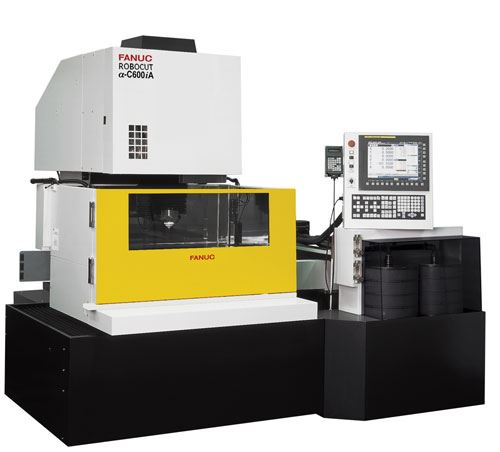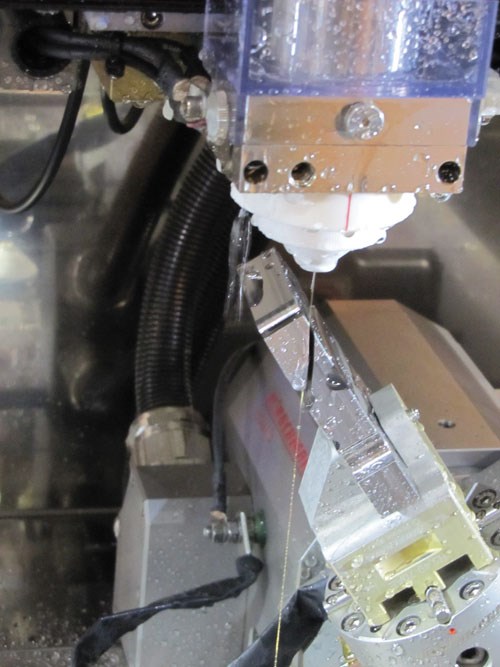Straight Talk about Cutting Steep Tapers with Wire EDM
The RoboCut C400iA and two sizes of the larger C600iA wire EDM machines from Methods Machine Tools enable unusually steep tapers to be cut with the wire EDM process by positioning the workpiece with a rotary-tilt table.
Share




Methods Machine Tools, Inc.A new series of FANUC wire EDM machines from Methods Machine Tools (Sudbury, Massachusetts) includes options that “take a different angle” for cutting steep tapers on complex parts for medical, aerospace and other demanding applications. The key concept is not “angling” the wire at all. Instead, the strategy is to tilt and rotate the workpiece, while keeping the wire straight up and down as it moves through the wire guides. This series of wire machines, which consists of the RoboCut C400iA and two sizes of the larger C600iA, accomplishes this strategy through innovations in workpiece positioning (a programmable rotary-tilt table), CAM programming software (special algorithms to control movement of the workpiece in multiple axes simultaneously), enhanced automatic wire rethreading (designed to work reliably even when the wire guides are widely separated) and advanced power supply technology (a combination of electronic and mechanical capabilities). Because all of these developments involve a high level of automation, they also make long periods of untended operation possible.
Typically, wire EDM machines equipped to cut tapers have employed U- and V-axis movements to enable the wire to approach the workpiece at an angle. These axes independently displace the upper and lower wire guides from their normal position in which they are directly opposed in Z to hold the wire perpendicular to the X-Y work plane. As the U and V axes move away from normal, the wire tilts in proportion to the displacement.
According to Stephen Bond, national sales manager for FANUC EDM products at Methods Machine Tools, tilting the wire in this manner has disadvantages that the new wire machines seek to avoid. Tilting the wire can degrade cutting performance because reduced wire tension and poor flushing conditions adversely affect accuracy, cutting speed and surface finish. These results become more pronounced as the angle of the wire tilt increases, thus making steep tapers particularly problematic, he says.
To cut steep tapers more effectively, the new RoboCut wire machines can be equipped with a Hirschman A/B indexing and tilting table that tilts and rotates the workpiece simultaneously under programmed command. This unit orients the workpiece at an angle to the electrode wire, which can remain in its normal, perpendicular position for optimal flushing and wire tension. This enables the wire to cut steeply angled features such as slots with compound curves. The photo above shows an example of a slot being cut in a saw guide used in knee replacement surgery. This part can be completed in one setup because it is not necessary to refixture the part for cuts at different angles.
Programming these intricate moves is challenging, so Methods worked with CAM developer Camtek (Atlanta, Georgia) to develop software that helps prepare simultaneous five-axis moves. This satisfies users looking for a single source of tapering capability and the necessary programming software as a complete package.
Another enabling technology for cutting steep tapers is FANUC's automatic wire rethreading system, which is designed to rethread the wire reliably even when a part positioned at an angle requires cutting at maximum wire height (as much as 16 inches on the largest model in this series). Mr. Bond says the rethreading system enables the wire to be annealed and stretched slightly so that it parts with a naturally pointed tip that aids entry into the funnel-shaped opening of the lower wire guide. This system ensures that process time is not extended by repeated attempts to thread the wire or by lowering the part back down to table height. Most importantly, reliable rethreading facilitates complete part processing in one setup, a capability made possible by automatic A/B axis positioning.
Because many complex, difficult-to-machine aerospace parts involve tight corners, deep slots and features at multiple angles, processing these parts with wire EDM has long been an enticing prospect—especially with the development of steep taper capability. What makes this possible on the new RoboCut machines is a combination of spark formation technology in the spark generator and mechanical control of the power contacts in the wire feed system. Together, this combination enables settings on the final skim cuts to prevent a recast layer (virtually undetectable at 1,000:1 magnification) from forming on the surface of the workpiece. Eliminating this layer ensures that the EDMed surface retains the same material properties as the underlying alloy, without the microcracking or inclusions that previously discouraged use of EDM on critical aerospace parts.
Mr. Bond explains that the success of this combination lies in two factors. One is the ability to generate sparks in a precise waveform by modulating the intensity and duration of electrical energy released in each spark. This waveform erodes the workpiece material without letting it reattach to the surface, thus eliminating the recast layer. The other is the ability to selectively disengage one set of power contacts, thus removing a source of stray capacitance which can interfere with the effectiveness of this spark waveform.
The new machines also features several new control enhancements designed to reduce overall operational costs by minimizing energy usage in system components. Running in an “Eco Mode” further reduces costs by lowering wire consumption by as much as 30 percent.
Related Content
How to Successfully Adopt Five-Axis Machining
While there are many changes to adopt when moving to five-axis, they all compliment the overall goal of better parts through less operations.
Read More6 Machine Shop Essentials to Stay Competitive
If you want to streamline production and be competitive in the industry, you will need far more than a standard three-axis CNC mill or two-axis CNC lathe and a few measuring tools.
Read MoreOrthopedic Event Discusses Manufacturing Strategies
At the seminar, representatives from multiple companies discussed strategies for making orthopedic devices accurately and efficiently.
Read MoreHow to Mitigate Chatter to Boost Machining Rates
There are usually better solutions to chatter than just reducing the feed rate. Through vibration analysis, the chatter problem can be solved, enabling much higher metal removal rates, better quality and longer tool life.
Read MoreRead Next
5 Rules of Thumb for Buying CNC Machine Tools
Use these tips to carefully plan your machine tool purchases and to avoid regretting your decision later.
Read MoreRegistration Now Open for the Precision Machining Technology Show (PMTS) 2025
The precision machining industry’s premier event returns to Cleveland, OH, April 1-3.
Read MoreBuilding Out a Foundation for Student Machinists
Autodesk and Haas have teamed up to produce an introductory course for students that covers the basics of CAD, CAM and CNC while providing them with a portfolio part.
Read More























.jpg;maxWidth=300;quality=90)









.jpg;maxWidth=970;quality=90)